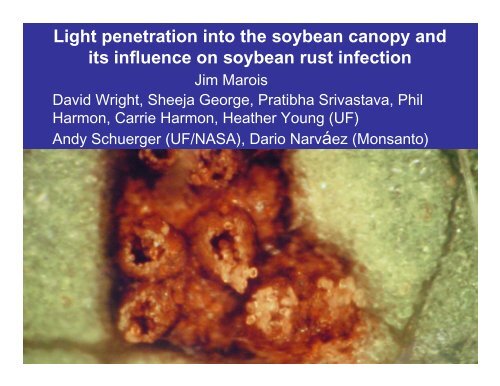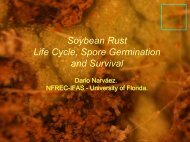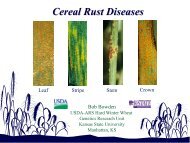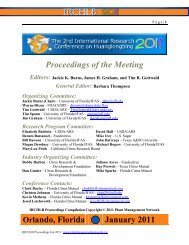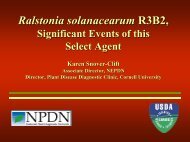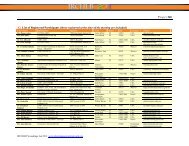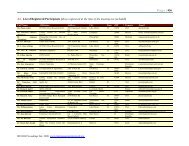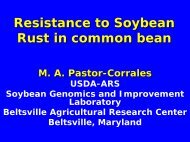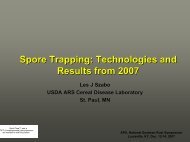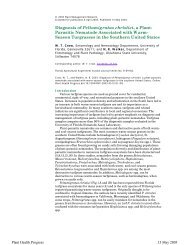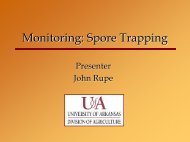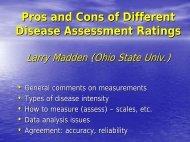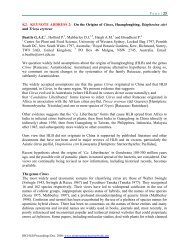Light penetration into the soybean canopy and its influence - Plant ...
Light penetration into the soybean canopy and its influence - Plant ...
Light penetration into the soybean canopy and its influence - Plant ...
You also want an ePaper? Increase the reach of your titles
YUMPU automatically turns print PDFs into web optimized ePapers that Google loves.
<strong>Light</strong> <strong>penetration</strong> <strong>into</strong> <strong>the</strong> <strong>soybean</strong> <strong>canopy</strong> <strong>and</strong><br />
<strong>its</strong> <strong>influence</strong> on <strong>soybean</strong> rust infection<br />
Jim Marois<br />
David Wright, Sheeja George, Pratibha Srivastava, Phil<br />
Harmon, Carrie Harmon, Hea<strong>the</strong>r Young (UF)<br />
Andy Schuerger (UF/NASA), Dario Narváez (Monsanto)
SBR progress up <strong>canopy</strong><br />
Early Epidemic Mid Epidemic Late Epidemic
The Electromagnetic Spectrum<br />
As you go from left to right <strong>the</strong>re is decreasing<br />
energy, decreasing frequency, <strong>and</strong> increasing<br />
wavelength
Visible light?<br />
As frequency gets higher, energy gets higher
Name<br />
Ultra Violet Radiation<br />
Abbreviation<br />
Wavelength<br />
Range<br />
Ultraviolet A UVA 400 nm–320 nm<br />
Ultraviolet B UVB 320 nm–280 nm<br />
Ultraviolet C UVC 280 nm–100 nm<br />
Vacuum UV VUV 100 nm–10 nm
Sun Energy 8% UV, 39% visible, 53% infrared<br />
C B A<br />
260 nm is most<br />
damaging to DNA<br />
http://upload.wikimedia.org/wikipedia/commons/4/4c/Solar_Spectrum.png
UV Index November 23, 2009<br />
UV Index Forecast<br />
UV-index
Photosyn<strong>the</strong>tic Active Radiation<br />
PAR absorption<br />
affects <strong>the</strong><br />
quality of light<br />
<strong>the</strong> lower<br />
<strong>canopy</strong> spores<br />
are exposed to.<br />
http://en.wikipedia.org/wiki/File:Par_action_spectrum.gif
Impact of light on disease<br />
• PAR necessary for plant health<br />
• Solar radiation can directly reduce spore survival<br />
(especially UVB)<br />
• Solar radiation increases <strong>canopy</strong> temperature<br />
<strong>and</strong> reduces humidity<br />
• Solar radiation is reduced by <strong>canopy</strong> shading,<br />
thus older leaves are usually more shaded<br />
• Spore release often involves some form of<br />
desiccation
Two experiments were conducted to<br />
manipulate <strong>the</strong> <strong>canopy</strong> microclimate –<br />
The first involved manipulating <strong>the</strong> row width<br />
(18, 38, <strong>and</strong> 76 cm) while using <strong>the</strong> same<br />
seeding rate of 470,000 plants per hectare<br />
The second involved manipulating <strong>canopy</strong><br />
microclimate by applying shade cloth at 0, 30,<br />
40, <strong>and</strong> 60% to <strong>soybean</strong>s in <strong>the</strong> field
Row spacing study<br />
(18, 38, 78 cm between rows)
Row Spacing Study<br />
Objective<br />
Evaluate <strong>the</strong> effect of row spacing (18, 38, <strong>and</strong><br />
76 cm) on disease increase<br />
Effects of Row Spacing <strong>and</strong> Canopy Height on<br />
Spatio-Temporal Development of Asian<br />
Soybean Rust<br />
P. ESKER, D. Narváez, J. Marois, D. Wright, E. De Wolf, M.<br />
Nita, E. Del Ponte, <strong>and</strong> S. Isard 2007 APS Soybean Rust<br />
Symposium Poster
20 X 20 m<br />
plot<br />
Disease<br />
assessed<br />
weekly at<br />
every 3 m<br />
grid point<br />
at low,<br />
mid, <strong>and</strong><br />
upper<br />
<strong>canopy</strong>
Conclusion<br />
By 59 DAI, it appears that ASR spread <strong>the</strong><br />
fur<strong>the</strong>st in <strong>the</strong> 76 cm row spacing. This was<br />
likely due to <strong>the</strong> increase in air movement, <strong>and</strong><br />
thus spore movement, down <strong>the</strong> wider rows.<br />
These data are being fur<strong>the</strong>r analyzed.
Shade Plot Study<br />
Objective<br />
Evaluate <strong>the</strong> effect of solar radiation on disease<br />
increase, <strong>canopy</strong> microclimate <strong>and</strong> cuticular wax<br />
thickness<br />
(plant leaves often produce more cuticular wax<br />
under higher light conditions, which may serve<br />
as a barrier to <strong>the</strong> direct <strong>penetration</strong> of<br />
pathogens)
• 3 X 3 m shade structures<br />
(4 sided, open on north side)<br />
– 30%, 40%, 60%, control<br />
• Constructed over <strong>soybean</strong>s<br />
at growth stage V3-V4,<br />
subsequent leaves marked<br />
• Recorded temperature,<br />
relative humidity, disease<br />
severity<br />
• Leaves were collected at R1<br />
for susceptibility assays &<br />
cuticle analysis<br />
• Conducted over 2 years,<br />
with 2 plantings each year
Evaluations were done weekly, starting 10–14<br />
days after inoculation (0.5 L of 70,000 spores/ml)<br />
or at R1 if naturally infected. Sampled 10 times at<br />
lower, middle, <strong>and</strong> upper <strong>canopy</strong> levels for each<br />
evaluation.
Disease development<br />
CONTROL<br />
60% SHADE
Leaves collected at R1 were placed on agar after<br />
being inoculated with ~21,000 spores/mL, ~3ml/leaf,<br />
<strong>and</strong> evaluated 10 to 14 days after inoculation
Disease development from leaves at mid<br />
<strong>canopy</strong> level<br />
CONTROL<br />
30% SHADE<br />
40% SHADE 60% SHADE
Cuticular Wax Thickness
Effect of Shade on Temperature<br />
0 % SHADE 30 % SHADE 40 % SHADE 60 % SHADE<br />
35.00<br />
Tem perature (C)<br />
30.00<br />
25.00<br />
20.00<br />
15.00<br />
10.00<br />
0 1 2 4 5 6 8 9 10 12 13 14 16 17 18 20 21 22<br />
Time of Day
Effect of Shade on Relative Humidty<br />
0 % SHADE 30 % SHADE 40 % SHADE 60 % SHADE<br />
% Relative Humidity<br />
100.00<br />
90.00<br />
80.00<br />
70.00<br />
60.00<br />
50.00<br />
40.00<br />
0 1 2 4 5 6 8 9 10 12 13 14 16 17 18 20 21 22<br />
Time of Day
Conclusions<br />
• Greater disease severity in 40% & 60% shaded<br />
plots<br />
• Similarly, in leaf assays in <strong>the</strong> middle <strong>and</strong> upper<br />
<strong>canopy</strong> 40% & 60% shaded leaves have<br />
increased severity<br />
• Trend of higher amount of cuticular wax in<br />
control across <strong>canopy</strong> levels<br />
• Temperature <strong>and</strong> RH affected by shade cloth,<br />
regardless of thickness
In ano<strong>the</strong>r related study<br />
Trans-Oceanic Dust Plumes:<br />
Long Distance Dispersal of Microorganisms<br />
(during south Florida summer up to 80% of<br />
suspended dust originates in Africa)
Effect of solar radiation on spore survival<br />
Objectives<br />
Quantify <strong>the</strong> solar radiation in <strong>the</strong> <strong>soybean</strong><br />
<strong>canopy</strong><br />
Evaluate <strong>the</strong> effect of solar radiation on spore<br />
germination under field <strong>and</strong> laboratory<br />
conditions
Optronic OL754
Energy values (W/m2)<br />
Canopy location UVB UVA PAR<br />
Upper 3.00 43.8 328.3<br />
Middle 1.19 10.5 78.7<br />
Lower 0.34 3.26 14.9<br />
As percentage of upper <strong>canopy</strong><br />
Canopy location UVB UVA PAR<br />
Upper 100% 100 100<br />
Middle 40 23 23<br />
Lower 11 7 4
Full Solar Spectum vs 30, 40, <strong>and</strong> 60% Shade Cloth<br />
2.5<br />
2.0<br />
Full Sun Spectrum<br />
30% Shade Cloth<br />
40% Shade Cloth<br />
60% Shade Cloth<br />
Irradiance (W/m 2 )<br />
1.5<br />
1.0<br />
0.5<br />
0.0<br />
300 400 500 600 700 800<br />
Wavelength (nm)
Energy values (W/m2)<br />
Shade Treatment UVB UVA PAR<br />
Full sun (no shade) 3.37 47.53 349.2<br />
30% shade 2.32 31.57 226.0<br />
40% shade 1.84 24.66 173.7<br />
60% shade 1.23 16.22 111.9<br />
Shade Treatment UVB UVA PAR<br />
Full sun (no shade) 100 100 100<br />
30% shade 36 34 32<br />
40% shade 54 52 50<br />
60% shade 69 66 65
Xenon lamp to simulate natural sunlight
UV-VIS-NIR Spectrum of <strong>the</strong> Xenon 6269 Lamp<br />
2.5<br />
2.0<br />
Full UV-VIS-NIR Spectrum (0 screens)<br />
50% Flux (3 screens)<br />
10% Flux (7 screens)<br />
Irradiance (W/m 2 )<br />
1.5<br />
1.0<br />
0.5<br />
0.0<br />
300 400 500 600 700 800<br />
Wavelength (nm)
Effect of Simulated Solar Radiation on Spore Survival<br />
Percent Germination (Normalized)<br />
120<br />
100<br />
80<br />
60<br />
40<br />
20<br />
0<br />
100% 50% 10%<br />
1 2 3 4 5 6 7 8 9<br />
Hours of Exposure
Effect of Simulated Solar Radiation on Spore Survival<br />
Percent Survival (Normalized)<br />
1.20<br />
1.00<br />
0.80<br />
0.60<br />
0.40<br />
0.20<br />
0.00<br />
X<br />
y = -0.0704x + 0.9065<br />
R 2 = 0.6932<br />
0.00 2.00 4.00 6.00 8.00 10.00 12.00 14.00<br />
Simulated Solar Irradiance MJ/M 2 /8 hr
Relationship between total solar irradiance <strong>and</strong> <strong>the</strong> normalized germination<br />
proportions of exposed Phakopsora pachyrhizi urediniospores.<br />
X<br />
/8 hr<br />
Isard, S. A., Dufault, N. S., Miles, M. R., Hartman, G. L., Russo, J. M., De Wolf, E. D., <strong>and</strong><br />
Morel, W. 2006. The effect of solar irradiance on <strong>the</strong> mortality of Phakopsora pachyrhizi<br />
urediniospores. <strong>Plant</strong> Dis. 90:941-945.
Soybean rust incidence at different daily solar radiation intensities resulting from various<br />
shading effects. Incidence values were st<strong>and</strong>ardized to <strong>the</strong> highest values observed in<br />
each trial.<br />
X<br />
In A. Dias Dissertation “Epidemiological studies of shading effects on Asian<br />
<strong>soybean</strong> rust” Iowa State University, 2008<br />
A.P.S. Dias, X. Li, P.F. Harmon, C.L. Harmon, <strong>and</strong> X.B. Yang Effects of shade<br />
intensity <strong>and</strong> duration on Asian <strong>soybean</strong> rust caused by Phakopsora pachyrhizi<br />
Submitted to <strong>Plant</strong> Disease.
Conclusions<br />
• Penetration of UVB higher compared to PAR <strong>and</strong> UVA,<br />
with PAR being captured by <strong>the</strong> leaves for<br />
photosyn<strong>the</strong>sis<br />
• As little as 1 hour of 100% sunlight begins to reduce<br />
spore survival, but even after 8 hours 20% or more can<br />
still germinate<br />
• The reduced light in <strong>the</strong> lower <strong>canopy</strong> is more conducive<br />
to spore survival
Overall<br />
Conclusions<br />
• Lower <strong>canopy</strong> disease is increased in part due to lower<br />
light conditions<br />
• Urediniospores in <strong>the</strong> lower <strong>canopy</strong> are exposed to less<br />
light <strong>and</strong> <strong>the</strong>ir survival is significantly longer<br />
• Decrease in light due to <strong>canopy</strong> density can result in<br />
reduced temperatures, increased RH <strong>and</strong> reduced<br />
cuticular wax, confounding <strong>the</strong> direct impact of light<br />
O<strong>the</strong>r factors include more dew in lower <strong>canopy</strong>, rain<br />
washing spores from upper <strong>canopy</strong>, some older leaves<br />
are more susceptible to SBR
This work was supported by <strong>the</strong> North<br />
Central Soybean Research Program, <strong>the</strong><br />
National Science Foundation, <strong>the</strong> United<br />
States Department of Agriculture, <strong>and</strong> <strong>the</strong><br />
National Aeronautics <strong>and</strong> Space<br />
Administration


